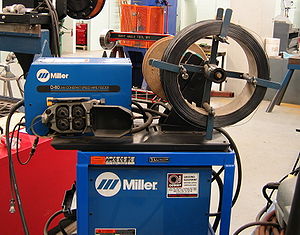Flux-cored arc welding
Flux-cored arc welding (FCAW) is a semi-automatic or automatic arc welding process using a continuously fed consumable tubular electrode filled with a flux. The arc requires a constant voltage or, less commonly, a constant current welding power supply. An externally supplied shielding gas is sometimes supplied, but often the flux itself is relied upon to generate the necessary protection from the atmosphere. The process is widely used in construction because of its high welding speed and portability.
FCAW was first developed in the early 1950’s as an alternative to shielded metal arc welding (SMAW). The advantage of FCAW vs. SMAW was that the use of stick electrodes (like those used in SMAW) was unnecessary. This helped FCAW to overcome many of the restrictions associated with SMAW.
Types
The first type of FCAW is the type that requires no shielding gas. This is made possible by the flux core in the tubular consumable electrode. However, this core contains more than just flux; it also contains various ingredients that when exposed to the high temperatures of welding generate a shielding gas for protecting the arc. This type of FCAW is preferable because it is portable and has excellent penetration into the base metal. Also, the conditions of air flow do not need to be considered.
The second type of FCAW actually uses a shielding gas that must be supplied by an external supply. This type of FCAW was developed primarily for welding steels. In fact, since it uses both a flux cored electrode and an external shielding gas, one might say that it is a combination of gas metal (GMAW) and flux-cored arc welding. This particular style of FCAW is preferable for welding thicker and out-of-position metals. The slag created by the flux is also easier to remove. However, it cannot be used in a windy environment as the loss of the shielding gas from air flow will produce visible porosity (small craters) on the surface of the weld.
Key process variables
- Wire feed speed (and current)
- Arc voltage
- Electrode extension
- Travel speed
- Electrode angles
- Electrode wire type
- Shielding gas composition (if required)[1]
Applications
FCAW is used on the following alloys:
- Mild and low alloy steels
- Stainless steels
- Some high nickel alloys
- Some wear-facing/surfacing alloys
Advantages
- May be an "all-position" process with the right filler metals
- No shielding gas needed
- High-deposition rate process in the 1G/1F/2F
- Some "high-speed" (e.g., automotive) applications
- Less pre-cleaning of metal required
- Metallurgical benefits from the flux such as the weld metal being protected initially from external factors until the flux is chipped away
- Low operator skill is required
Disadvantages
Of course, all of the usual issues that occur in welding can occur in FCAW such as incomplete fusion, slag inclusion, porosity, undercutting, etc . . . But there are a few concerns that come up with FCAW that are worth taking note of:
- Melted Contact Tip – happens when the electrode actually contacts the base metal, thereby fusing the two
- Irregular wire feed – typically a mechanical problem
- Porosity – the gases (specifically those from the flux-core) don’t escape the welded area before the metal hardens
See also
Notes and references
- ↑ FCAW wires that don't require a shielding gas commonly emit fumes that are extremely toxic; these require adequate ventilation or the use of a sealed mask that will provide the welder with fresh air.
Further reading
- Welding Handbook, Vol 2 (9th ed.). American Welding Society.
- Flux Cored Welding. Welding Procedures & Techniques. American Metallurgical Consultant (23 June 2006). Retrieved on November 2006.
- Groover, Mikell P. (2002). Fundamentals of Modern Manufacturing, 2nd ed.. New York City: John Wiley & Sons, Inc..
- Solid Wire Versus Flux-Cored Wire - When to Use Them and Why. Miller Electric Mfg. Co.. Retrieved on November 2006.
